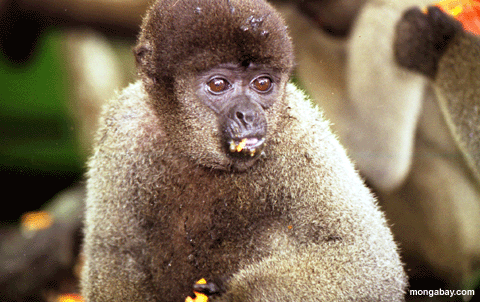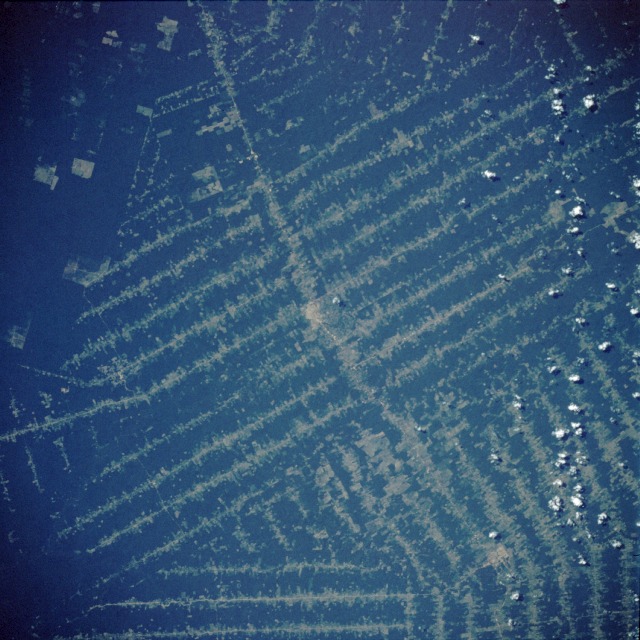Amazon deforestation lower than last year says Brazil
Rhett Butler, mongabay.com
August 27, 2005

Agriculture in the rainforests of Brazil.
Image courtesy of NASA [ID: STS086.ESC.00081556, Lat: 8.6°S, Long: 45.8°W]
Yesterday Brazil announced that 3,515 square miles (9,103 square kilometers) of Amazon rainforest were destroyed between August 2004 and July 2005, a marked decline from the 7,229 sq. mi. (18,723 sq. km.) in the same period a year earlier. While the government has tried to take credit for the drop, analysts say the slowing is more likely the result of lower commodity prices, giving farmers less incentive to clear forest land.
Record beef exports
The announcement comes at the same time that Brazil is experiencing record beef exports. Clearing for cattle pasture is widely cited as a major force behind deforestation in the Amazon rainforest, atlhough much of Brazil’s beef production actually occurs outside rainforest regions.
 Deforestation in Brazil: This image of the southern Amazon uses satellite data from the Moderate Resolution Imaging Spectroradiometer (MODIS) on the Terra satellite collected in 2000 and 2001 to classify the terrain into three separate land surface categories: forest (red), herbaceous (non-woody) vegetation like grasses (green), and bare ground (blue). The Amazon’s numerous rivers appear white. |
|||||||||||||||||||||||||||||||||||||||||||||||||||||||||||||||||||||||
|
|||||||||||||||||||||||||||||||||||||||||||||||||||||||||||||||||||||||
According to figures released by the Brazilian Confederation of Agriculture, over the 12-month period from August 2004 to July 2005, revenues from Brazilian beef exports totaled US$ 2.896 billion, 41% more than the US$ 2.057 billion registered between August 2003 and July 2004. Volume during this period went from 1.539 million tons exported between August 2003 and July 2004 to 2.188 million tons (August 2004 to July 2005). Russia , Egypt (US$ 159 million), Britain, Venezuela, and the United States are major markets for Brazilian beef and, at current rates, Brazil will maintain its position as world largest exporter of beef for the third year in a row.
Soybeans booming
Deforestation in the Amazon, as well as in the nearby cerrado grassland ecosystem, is also lately driven by soybean cultivation. Today soybeans are flourishing — since 1998, Brazil has added 30 million acres of soybeans and American firms are aggressively expanding their presence in the Brazilian agricultural sector. Brazil will likely soon supplant the United States as the world’s leading exporter of soybeans.
The growth of agriculture in the Amazon has necessitated the improvement of roads and highways in the region. The Brazilian and Peruvian governments are currently paving a road that leads from the heart of the Amazon to ports in Peru. Scheduled to be completed by June 2006, the road has already spurred deforestation by settlers seeking lands for subsistence agriculture.
Marred by violence
The movement these land hungry settlers into the region has produced violent conflicts over land rights with existing landowners. The Pastoral Land Commission, a nongovernmental group working in the region, found that land battles in Brazil’s countryside reached the highest level in at least 20 years in 2004. According to the annual report by the organization, documented conflicts over land among peasants, farmers and land speculators rose to 1,801 in 2004 from 1,690 conflicts in 2003 and 925 recorded in 2002. Tensions reach their peak earlier this year with the high profile slaying of Dorothy Stang, an American nun who worked with rural poor, by gunmen associated with plantation owners. In response to the murder, the Brazilian government sent in the army to quell violence in the region and promised to step up environmental monitoring efforts.
Still some locals view the government’s increased presence in the area as an ominous sign of things to come. According to a June 23 article in Los Angeles Times, many Brazilians are “convinced that foreign powers, in particular the United States, are making plans for a takeover of the world’s biggest tropical forest to secure the rights to its seemingly limitless natural resources.” 75% of Brazilians surveyed in a recent poll said they feared a foreign invasion provoked by their country’s natural riches. Environmentalists’ interests in the Amazon are seen as a way for foreigners to assert control over the region.
Environmentalists maintain that their intentions in the region are purely altruistic and based on the premise that the Amazon houses as much as 30% of the world’s biodiversity and provides critical local and global ecological services. Scientists say the Amazon forest plays a key role in the global environment, supplying a portion of the world’s oxygen and locking up massive amounts of carbon. As forest is cut, carbon dioxide is released into the atmosphere contributing to the accumulation of greenhouse gases in the atmosphere. Further, scientists have found that the reduction of forest cover has affected local weather patterns. Less rain tends to fall in deforested areas and scientists fear that continued forest clearing could turn much of the region into savanna. A recent study in Science warned that a prolonged drought in the Amazon could lead to a massive die-off in the world’s largest rainforest.
 Woolly monkey, Brazil More tropical rainforest animal photos. |
|
Home to up to 30 percent of the world’s plant and animal species, including a new species of monkey discovered earlier this year, the Amazon is said to hold a great deal of promise in the development of drugs and other useful products derived from its biodiversity. Through bioprospecting this economic potential is increasingly being realized and a number of pharmaceutical products have been derived from plants in the region. Indigenous populations have rational uses for thousands more.
More on deforestation in Brazil.
Further reading
- Brazil’s growth as agricultural giant has cost — LA Times (August 22, 2005) Saturday, the Los Angeles Times featured an article on Brazil’s drive to become an agricultural giant. The country’s breakneck growth has made it the world’s biggest exporter of many agricultural products, but at a cost: some of Brazil’s richest ecological areas have been plowed under for crops. Brazil has the highest biological diversity of any country on Earth.
- Brazil to crackdown on illegal logging says Environment Minister (August 9, 2005) According to a report from Bloomberg, Brazil will increase the monitoring of logging in the Amazon rainforest and raise fines for those caught illegally clearing trees.
- Landowner caught burning 2 million trees in the Amazon (August 3, 2005) A large plantation owner was caught burning almost 2 million trees in the Amazon to make way for a cattle pastures according to O Estado de S.Paulo, as translated by amazonia.org.br. Workers for Jose Dias Pereira, a landholder in the Brazilian state of Para, were caught by Inspectors from the Brazilian Institute for the Environment and Renewable Natural Resources (IBAMA) and military police. IBAMA says this is the largest area of deforestation registered this year in Amazonia and has fined Pereira $770,000 (R$ 20.5 million reales).
- Brazil’s grasslands could replace food production of American heartland (August 1, 2005) Today when Brazil is mentioned in the same sentence with “agriculture,” people often first envision the Amazon rainforest giving way to soybean plantations and cattle farms. While the Amazon is being converted for such purposes, the cerrado, a vast area of savanna-like grasslands covering more than 20% of the country’s surface area, is increasingly under threat as farmers from the United States and Europe are setting their sights on the biome’s sizeable agricultural potential.
- Paving of road brings change in the Amazon rainforest (May 27, 2005)
Burly truckers share thermoses of sweet coffee, cook rice and beans on camp stoves and lounge in the sweltering shade of broad-leafed palms as they wait for a front-end loader to tow their rigs through a half-mile stretch of waist-deep mud deep in the Amazon jungle. - Rainforest loss in the Amazon tops 200,000 square miles, new figures from Brazilian government (May 21, 2005) New figures from the Brazilian government show that 10,088 square miles of rain forest were destroyed in the 12 months ending in August 2004. Deforestation in the Amazon in 2004 was the second worst ever as rain forest was cleared for cattle ranches and soy farms. Scientists are concerned that widespread deforestation in the Amazon could have global consequences through species extinction and climate change.
- Chinese demand drives road-building and deforestation in the Amazon (April 7, 2005) The state of Madre de Dios in southeastern Peru is home to mountainous cloud forests and low-lying rainforests containing the richest biodiversity on Earth. It may also soon be home to a transcontinental highway. If all goes according to plan and schedule, by June 2006, there will be an asphalt road connecting Sao Paulo to Lima, and more importantly, the Pacific Peruvian ports of Matarini, Ilo and San Juan. The east-west Carretera Transoceanica — “transoceanic highway” — as the project is called, is viewed as a long-awaited and close to finalized dream for proponents, namely the Peruvian and Brazilian governments, agricultural groups and local residents, and as a nightmare for environmentalists.
- Brazil’s grass-fed cattle are its economic salvation – beef exports are soaring: Brazilian agriculture has the benefit of vast pasturelands, low labor costs and a talented entrepreneurial class. As trade expands and access to agricultural technologies improves, Brazil’s growing role in the global food trade is helping reshape that market. This new competition is undermining the U.S.’s long domination of agricultural exports and the political clout that comes with it. Since 1998, Brazil’s beef exports have tripled, setting the country on course this year to pass Australia as the world’s top exporter of beef, by volume, according to the U.S. Department of Agriculture
- Groups Clash Over Soybean Boom in Brazil: A new variety of soybean developed by Brazilian scientists to flourish in this punishing equatorial climate is good for farmers, putting South America’s biggest country on the verge of supplanting the United States as the world’s leading exporter
- The Impact of Growing Demand for Beef on the Amazon Rainforest in Brazil: Brazil’s spectacular and growing success as a prime exporter of beef-volume of exports abroad have increased more than fivefold in the last six years-is responsible for much of the recent spike in the destruction of the Amazon rainforest, according to a study released today by one of the world’s leading forestry research organizations. In a report summarizing their work*, the researchers demonstrate a strong link between the dramatic deforestation rates, which the Brazilian government is expected to announce shortly, and the growth in exports that have caused a massive surge in the Brazilian Amazon’s cattle population-from 26 million head in 1990 to 57 million in 2002.
- Farmers and landless poor battle over the Amazon: Land battles in Brazil’s countryside reached the highest level in at least 20 years in 2004 as activists clashed with farmers and loggers advancing on savanna and Amazon rain forest.
- Slavery exists out of sight in Brazil: MARABA, Brazil – Jose Silva came to the Macauba Ranch in Brazil’s eastern Amazon hoping to earn a few hundred dollars clearing jungle. Two years later, he was $800 in debt and terrified that if he tried to leave the ranch, Gilmar the field boss would pull out his .38 revolver and kill him.
|
|

